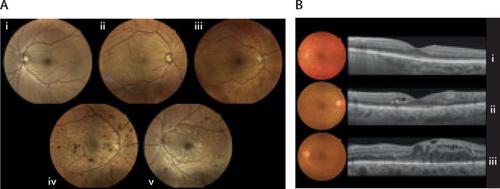当前位置:
X-MOL 学术
›
Lancet Diabetes Endocrinol.
›
论文详情
Our official English website, www.x-mol.net, welcomes your
feedback! (Note: you will need to create a separate account there.)
Screening for diabetic retinopathy: new perspectives and challenges.
The Lancet Diabetes & Endocrinology ( IF 44.0 ) Pub Date : 2020-02-27 , DOI: 10.1016/s2213-8587(19)30411-5 Stela Vujosevic 1 , Stephen J Aldington 2 , Paolo Silva 3 , Cristina Hernández 4 , Peter Scanlon 2 , Tunde Peto 5 , Rafael Simó 4
The Lancet Diabetes & Endocrinology ( IF 44.0 ) Pub Date : 2020-02-27 , DOI: 10.1016/s2213-8587(19)30411-5 Stela Vujosevic 1 , Stephen J Aldington 2 , Paolo Silva 3 , Cristina Hernández 4 , Peter Scanlon 2 , Tunde Peto 5 , Rafael Simó 4
Affiliation

|
Although the prevalence of all stages of diabetic retinopathy has been declining since 1980 in populations with improved diabetes control, the crude prevalence of visual impairment and blindness caused by diabetic retinopathy worldwide increased between 1990 and 2015, largely because of the increasing prevalence of type 2 diabetes, particularly in low-income and middle-income countries. Screening for diabetic retinopathy is essential to detect referable cases that need timely full ophthalmic examination and treatment to avoid permanent visual loss. In the past few years, personalised screening intervals that take into account several risk factors have been proposed, with good cost-effectiveness ratios. However, resources for nationwide screening programmes are scarce in many countries. New technologies, such as scanning confocal ophthalmology with ultrawide field imaging and handheld mobile devices, teleophthalmology for remote grading, and artificial intelligence for automated detection and classification of diabetic retinopathy, are changing screening strategies and improving cost-effectiveness. Additionally, emerging evidence suggests that retinal imaging could be useful for identifying individuals at risk of cardiovascular disease or cognitive impairment, which could expand the role of diabetic retinopathy screening beyond the prevention of sight-threatening disease.
中文翻译:

糖尿病性视网膜病变的筛查:新观点和新挑战。
尽管自1980年以来在糖尿病控制水平提高的人群中,糖尿病视网膜病变的所有阶段的患病率一直在下降,但1990年至2015年间,全世界由糖尿病视网膜病变引起的视力障碍和失明的粗略患病率有所增加,这在很大程度上是由于2型糖尿病的患病率增加,尤其是在低收入和中等收入国家。筛查糖尿病性视网膜病对于检测需要及时进行全面眼科检查和治疗以避免永久性视力丧失的参考病例至关重要。在过去的几年中,已经提出了考虑多种风险因素的个性化筛选间隔,并具有良好的成本效益比。但是,许多国家缺乏用于全国筛查计划的资源。新技术,例如,利用超广角成像和手持移动设备扫描共聚焦眼科,用于远程分级的远眼科和用于糖尿病性视网膜病变的自动检测和分类的人工智能,正在改变筛查策略并提高成本效益。此外,新出现的证据表明,视网膜成像可用于识别有心血管疾病或认知障碍风险的个体,这可能将糖尿病性视网膜病筛查的作用扩大到预防视力障碍的疾病。
更新日期:2020-03-19
中文翻译:

糖尿病性视网膜病变的筛查:新观点和新挑战。
尽管自1980年以来在糖尿病控制水平提高的人群中,糖尿病视网膜病变的所有阶段的患病率一直在下降,但1990年至2015年间,全世界由糖尿病视网膜病变引起的视力障碍和失明的粗略患病率有所增加,这在很大程度上是由于2型糖尿病的患病率增加,尤其是在低收入和中等收入国家。筛查糖尿病性视网膜病对于检测需要及时进行全面眼科检查和治疗以避免永久性视力丧失的参考病例至关重要。在过去的几年中,已经提出了考虑多种风险因素的个性化筛选间隔,并具有良好的成本效益比。但是,许多国家缺乏用于全国筛查计划的资源。新技术,例如,利用超广角成像和手持移动设备扫描共聚焦眼科,用于远程分级的远眼科和用于糖尿病性视网膜病变的自动检测和分类的人工智能,正在改变筛查策略并提高成本效益。此外,新出现的证据表明,视网膜成像可用于识别有心血管疾病或认知障碍风险的个体,这可能将糖尿病性视网膜病筛查的作用扩大到预防视力障碍的疾病。











































 京公网安备 11010802027423号
京公网安备 11010802027423号